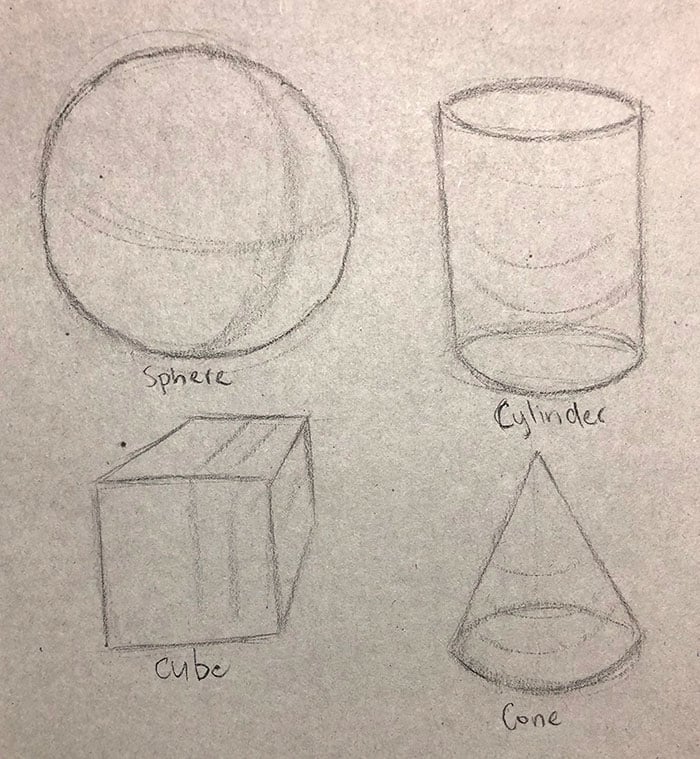Form is a visual element that refers to the illusion of a three-dimensional object on a two-dimensional surface. If your paintings look “flat” and uninviting, it is probably due to poor use of form.
- Major Forms: Sphere, Cube, Cylinder, and Cone
- Difference Between Shape and Form
- Form and Simplification
- How to Depict Form?
- Tips for Learning Form
- Thanks for Reading!
Major Forms: Sphere, Cube, Cylinder, and Cone
The major forms you need to be aware of are sphere, cube, cylinder, and cone (refer to an extract from my sketchbook below).

These are geometric forms. They are mathematical.
Forms that have no mathematical structure are organic forms. They are irregular and random by nature.
In practice, it is much more effective to look for geometric forms in your subject because they are easier to reliably measure and draw. Also, most organic forms can be simplified into geometric forms (more on that later in this post).
Difference Between Shape and Form
Shape refers to a two-dimensional (flat), enclosed area, whereas form appears three-dimensional (it looks like something you could hold in your hand).
An interesting point about shape and form is that form without any sense of shading or perspective will look like a shape.
Take the sphere below. What would it look like without the shading and the cast shadow?

Answer: A circle (which is a shape).
The same goes for a cube, cone, or cylinder.
A cube with no perspective looks like a square.
A cone with no perspective looks like a triangle.
A cylinder with no perspective looks like a rectangle.

Form and Simplification
Form plays an important role in the simplification of a subject. If you are able to see the basic forms through all the “noise”, you will be able to paint a more convincing image as you will have a better feel and understanding of the subject. You will know why the subject looks the way it looks rather than having to rely entirely on observation.
In practice, I start by looking for basic shapes, then I move into forms if necessary. As mentioned earlier, shape can represent a simplified version of form. So it makes sense to start with shape.
Keep in mind that not everything needs to be painted with a sense of form. Here are some examples:
- Areas that are actually flat (floor, wall, etc).
- Distant objects. The closer the object, the more apparent the form is. For distant objects, shape tends to be sufficient.
- Unimportant areas that you want to appear flat and uninviting (perhaps a distant figure walking in the background).
Learning how to see basic shapes and forms is something you will need to train actively. You will need to learn how to tune out the vast amount of noise and information so that only the basic shapes and forms remain.
I will run through some examples of form simplification below, starting with a beautiful drawing by Albrecht Dürer.





Also, as I mentioned earlier, organic forms can often be simplified into geometric forms. Take this Tasmanian cow pictured below.

As a whole, the cow is an irregular, organic form (outlined below).

But you can break this organic form down into smaller, geometric forms:

How to Depict Form?
Here are some of the common techniques used for rendering form:
- Use shading to pick up changes in light and shadow. This is perhaps the most effective technique. The idea is simple—planes of the form facing away from the light will be darker than planes facing towards the light. Below is a great example of this by Gustave Caillebotte.


- Ensure cast shadows are present and accurate. They help reinforce the form of the object and give it context. For example, take a look at the sphere below, after I removed the cast shadow. It seems to be floating in space.

- Follow contour lines to reiterate the form. Let your brush follow around, under, and over the form. Try to get a feel for it. In the drawing below, you can see the contour lines that Leonardo da Vinci used to explore and get a feel for the forms. Notice how the contour lines start off adventurous and loose, then gradually get more and more refined as the forms are consolidated.

- Use texture variance to reiterate the form. For example, you could use thick paint for the light planes and thin paint for the dark planes, as John Constable did in The Hay Wain.


- Use color variance to reiterate the form. In John Singer Sargent’s Siesta, warm colors are used for the light planes, whilst cool colors are used for the dark planes. This helps add a sense of form to the otherwise fleeting and relaxed painting.


Tips for Learning Form
Here are some tips for learning how to effectively use form in your paintings:
- Practice drawing the “perfect” sphere, cube, cylinder, and cone. A simple but highly effective exercise.
- Draw basic forms as a warm-up exercise (refer to an extract from my sketchbook below).
- See if you can simplify reference photos or master paintings down to basic shapes and forms.
- Incorporate figure drawing into your practice. The human figure is one of the best demonstrations of form in action.

Thanks for Reading!
I appreciate you taking the time to read this post and I hope you found it helpful. Feel free to share it with friends. If you ever want to learn more, check out myPainting Academycourse.
Happy painting!
Dan Scott

Draw Paint Academy
9K Shares
Dan Scott is the founder of Draw Paint Academy. He's a self-taught artist from Australia with a particular interest in landscape painting. Draw Paint Academy is run by Dan and his wife, Chontele, with the aim of helping you get the most out of the art life. You can read more on the About page.
